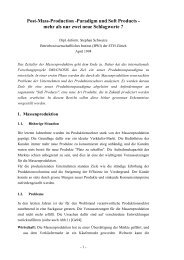The China Venture
The China Venture
The China Venture
You also want an ePaper? Increase the reach of your titles
YUMPU automatically turns print PDFs into web optimized ePapers that Google loves.
However, the characteristics of the mainland’s banking system have changed rapidly in only<br />
five years. Nevertheless, it is essential not to leave out a basic overview of the structure of the<br />
banking system in <strong>China</strong>. <strong>The</strong>refore Figure 2-3 shows the system as it is structured until now.<br />
At the beginning of the economic reform in the early eighties four specialised banks have<br />
been established: Industrial and Commercial Bank of <strong>China</strong> (ICBC), Bank of <strong>China</strong> (BOC),<br />
<strong>China</strong> Construction Bank (CCB, before March 26, 1996, it was called „People’s Construction<br />
Bank of <strong>China</strong>“) and Agricultural Bank of <strong>China</strong> (ABC). <strong>The</strong>ir major task is to grant policy<br />
loans to the state -owned enterprises (SOEs) of a specific economic sector. <strong>The</strong> areas of the<br />
four specialised banks provides an overview of their areas of specialty.<br />
Establishment Head office Specialised areas<br />
ICBC 1984 Beijing Handling industrial and commercial credits,<br />
loans and savings deposits<br />
BOC Originally in 1912 Shanghai since Handling foreign exchange and foreign<br />
1994<br />
trade<br />
CCB 1980s Beijing Lending long term financing for construction<br />
projects across the industries<br />
ABC 1980s Beijing Handling rural financial business<br />
TABLE 2-1: <strong>The</strong> areas of the four specialised banks 32<br />
In order to ease the financing pressure on the commercial banks and allow increased<br />
transparency and accountability in lending for large state-sponsored projects, three policy<br />
banks have been established in the middle of 1990s: <strong>The</strong> State Development Bank, the<br />
Agricultural Development Bank and the Ex- and Import Bank of <strong>China</strong> 33 . <strong>The</strong>y particularly<br />
provide long-term financing of important state projects. Nine banks, led by the Bank of<br />
Communications (Bocom), formed commercial banks, as the separation of the central and<br />
commercial banking functions began in 1987. <strong>The</strong> Bocom, which was founded in 1908, has<br />
its headquarter in Shanghai. Its branch in Hong Kong is one of the ten biggest banks there. It’s<br />
also the first bank in <strong>China</strong> in form of corporation with 50% state share of its registered<br />
capital. <strong>The</strong> other important commercial banks set up during this period include CITIC<br />
Industrial Bank, <strong>China</strong> Everbright Bank, <strong>China</strong> Investment Bank and <strong>China</strong> Merchants Bank<br />
as well as some regional development banks like Pudong Development Bank in Shanghai.<br />
Nearly all large Chinese banks are located in Shanghai. Private commercial banks are not<br />
typical for <strong>China</strong> until now, but the increasing emergence of such banks is quite obvious for<br />
the next future. <strong>China</strong> Minsheng Banking Corp. was <strong>China</strong>’s first privately owned bank,<br />
32 Source: Hannan, 1995, p. 51-52.<br />
33 Islam/Chowdhury, 1997, p. 279.<br />
26






